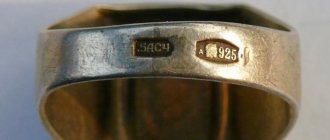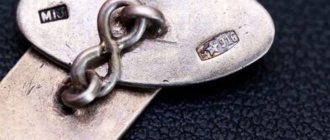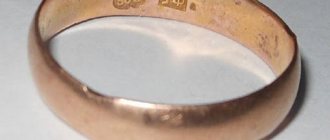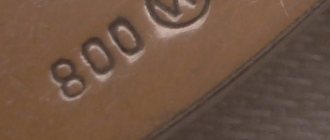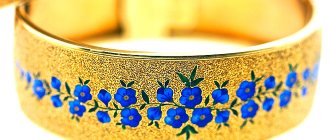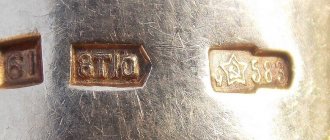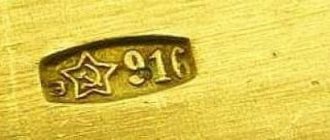Today, many types of jewelry are produced from alloys with different compositions. They differ in sample. Modern options: 375, 500, 585, etc. Among them, the option that complied with the USSR standard - 583 gold standard - is no longer mentioned. Despite the gradual transition to other types of products, many still have jewelry from those times.
Such jewelry has its advantages and disadvantages. But the transition from the most common standard in the post-Soviet countries (583) to European standards for determining quality (585) was associated not with the characteristics of the precious metal, but with a change in the structure of the state, which required transformations in all areas, including jewelry.
USSR gold - 583 standard with an asterisk, what is the value
A hallmark is a numerical designation that a precious metal receives when determining the content of its components. Products 583 corresponded to the gold standard adopted in the USSR. The test was introduced during the transition to the metric testing system (in 1927). This facilitated production - most of the products had a similar composition, the decorations differed mainly in shade.
The main share of the alloy was gold (58.3%), the rest was alloy.
The famous Soviet standard - 583 gold.
Today you can find jewelry with an asterisk. They do not have a modern hallmark. But on the back of the products there is still a mark - a five-pointed star, with a hammer and sickle on the inside. This is what a Soviet 583 ring looks like. Don't immediately suspect a fake.
Products of this type are authentic, but somewhat outdated. Their main value lies in their characteristics. If there is a star on a ring or bracelet, it means that the metal is durable, not prone to darkening, lasts a long time, and does not lose its attractiveness.
How is it different from 585 gold?
These alloys differ in their content of precious metal, although only by two tenths of a percent. Considering the remedium (permissible deviation) of 0.3%, the difference can either increase or disappear, so the difference is negligible. There is no noticeable difference in the strength and durability of identical gold products of 585 and 583 samples, but their cost will vary.
583 or 585 – which is better?
In fact, sample 583 has lost its relevance. Gold alloys of this purity are no longer used in jewelry making. But some collectors are ready to offer higher prices for Soviet-era items, as for antiques.
My personal example is the opposite: when I handed over a 583-carat piece to a jeweler, he was very reluctant to accept such jewelry from me.
Soviet gold alloy colors
The difference between metals of the same category (583 gold) is significant, and it lies mainly in shades:
| Gold Alloy Color | Ligature content,% |
| Yellow | Cu 33.7 + Ag 8 |
| Green | Cu 11.7 + Ag 30 |
| Red | Cu 41.7 |
| Pink | Cu 32 + Ag 9.7 |
| Pink-yellow | Cu 22.7 + Ag 19 |
| Citric | Cu 11.5 + Ag 30.2 |
| White | Cu 3 + Ag 11 + Ni 25 + Zn 2.7 |
The amount of gold in the table is the same for each case – 58.3%.
Gold rings 583 samples
Scope of application of this alloy
Due to its properties - strength, ductility, easy soldering, scratch resistance, this gold alloy has found wide application in the manufacture of jewelry intended for everyday use. Our grandmothers still wear, without removing, their favorite pendants, earrings or wedding rings, which are decorated with a sample with a star.
Brand with a star, what it looks like, history of origin, what it means
Today, 583 gold is not used for mass production of jewelry, otherwise the corresponding sample could be found on it. Its main distinguishing mark is the star-shaped mark. Previously (until 1958) they used a different marking - the head of a worker with a hammer. The sample changed, after which it quickly became recognizable.
This is a star containing a hammer and sickle, which means it belongs to the Soviet Union, since inside the sample there are the main elements of the coat of arms.
At the same time, the designation of the assay office has also changed. Cyrillic letters began to appear on jewelry of those times.
Application
Gold jewelry with a mark of 583 units was popular during the Soviet period. In the 90s, large men's rings made of gold alloy of this brand were famous.
Interesting: Many lovers of exquisite jewelry believe that products made of 583 precious metal in the Soviet Union were produced conscientiously and were distinguished by their quality.
At the moment, this sample costs no less than 585 markings, but due to the lack of 0.2 grams in the alloy, it is considered a material of the lowest category, and is not used in the production of precious jewelry. It is used to make custom items. Beautiful and aesthetic things made in vintage style look elegant and attractive.
The following are made from yellow metal marked 583:
- souvenirs;
- decorative products;
- piercing rings;
- pens;
- wrist watch;
- rings, earrings, pendants to order.
The secret of the popularity of the audition with a star
Soviet 583 gold, like many other things of that era, was distinguished by its monumentality and was created to last for many years. This also applied to jewelry. Earrings, chains, rings, bracelets, watches, jewelry sets, etc. - they complied with GOST, the production process was not disrupted.
The percentage of defects was minimal, almost approaching zero. In addition, gold 583 had a considerable number of advantages. The main advantage was considered to be the long service life of the products. This is due to its high hardness and resistance to mechanical stress.
As a result, earrings and rings did not change their appearance. This can be said about products of different colors - white, yellow, etc. But the numerous advantages would not be of much importance if the price were high. The cost of a troy ounce of gold during the Soviet Union was $200-300.
Soviet jewelry art versus modern jewelry: which is better?
Disputes among jewelry lovers about which gold standard is better, 583 or 585, continue to this day. Nostalgic citizens not only of our country, but also of neighboring countries, longingly remember the times when gold jewelry could be easily purchased without worrying about its quality. With the collapse of the Soviet Union, the standard for gold jewelry disappeared, giving way to the 585 standard accepted throughout the world.
Differences in GOST standards and quality
The models were produced according to established standards. This meant exact compliance with GOST standards in terms of composition percentage, melting characteristics and product durability. Jewelry with 583 hallmarks had massive dimensions, strength of composition and high performance properties.
The reason for changing the sample to 585. Which is better. The first GOST for gold
First of all, it is necessary to understand where the number 583 came from, if other assay systems used alloys with a similar composition, but a different designation - 585. In this case, translation between systems plays a key role. Calculation features:
- when the karat system is taken as a basis, the precious metal content in the alloy is taken into account, the conventional unit is 1/24 part (where 24 is pure gold), if we consider the features of hallmarking based on 14 carat metal, it turns out that such an alloy contains 14 parts of pure gold, due to simple calculations, the content of precious metal is determined - 583.33333;
- if the resulting value is converted back into the carat system, it turns out that the amount of gold will be less (13.9, not 14), this error is the main reason why the international community refused to recognize this type of metal.
The peculiarity of this situation is that the calculations take into account the permissible deviation of 0.3% (remedium). As a result, 583 samples appeared on the territory of the USSR. For this purpose, the value corresponding to the amount of gold in 1000 g of alloy was rounded down.
For comparison, in other countries where the metric system was in effect, rounding occurred upward.
The transition to European standards became possible after the collapse of the USSR. At the same time, the 583 standard lost its relevance, and a transition to 585 occurred. This was prompted by the situation on the foreign market: Soviet gold was rejected, it was accepted at the price of scrap. This was explained by the discrepancy between the samples.
Soviet-era gold earrings of 585 standard
When the transition from gold standard 583 to 585 occurred, the remedium also had to be taken into account, since it could have been provided for in the direction of increase. Because of this, when gold content was determined, a metal containing 58.9% of the precious component could be assayed, but jewelry with 58% could not.
The importance of accounting for remedium increases when the count goes into kilograms. For example, the fluctuation between the amount of gold 586 and 580 kg is significant. As a result, already in 1994, the 583 sample was changed to 585. However, the corresponding transformations were not made in the marking system. The old samples were still being stamped. Only closer to 2000 did stamps appear on all products that corresponded to the characteristics of the metal.
To regulate the production process of gold alloy jewelry, regulatory documents are taken as a basis. Today, the composition of alloys is determined by GOST 30649-99. Previously, among the first regulatory documents was GOST 17234-71. It contains calculations to determine the gold content, including in the composition of the 583 alloy.
Standards for marking the Russian hallmark on products
Jewelry of 583 samples contained on its surface:
- A numerical value indicating the content of pure noble metal in the composition;
- To the left of the sample there was a picture embossed in relief with a worker’s head and a hammer. This mark was relevant until 1958, during which time it was replaced by the image of a five-pointed star with the symbols of the USSR. During the years of perestroika and adjustment of products to European standards, the 583 hallmark was abolished and instead they began to use the 585 hallmark, which exactly corresponds to the 14 carats of the Western hallmark.
583-karat chain
However, the Soviet mark did not go away and did not sink into oblivion: after all, the population had and still has a lot of jewelry and expensive crafts made of gold of this marking. Therefore, metal with such a numerical value on the surface is bought, sold and accepted for processing even today.
It would be useful to note that the old mark was affixed to products right up to the spring of 2000, so you can see jewelry released after the collapse of the USSR with nostalgic markings on the surface.
Table: compare alloys, which is better: 583 or 585
There is a difference between metals containing 58.3% and 58.5% gold, but it is insignificant. Main features:
| Options | Alloys | |
| 583 | 585 | |
| Non-compliance with the standard according to the carat system – 14 carats | 0,01 | — |
| Remedium | 3 | 5 |
| Amount of gold | The metals are on the same level, despite the difference in gold content. The reason is the remedium. In nickel-based 585 alloys, the tolerance from the standard is greater, so the amount of pure gold contained in the alloy may actually be less | |
| Color | Red | White yellow |
| Wear resistance | High | Moderate |
Soviet era gold ring 585
Does gold darken
Gold jewelry of 583 and 585 samples, made without violating technology and not exposed to aggressive environments, does not darken. Jewelry should be protected from iodine, mercury, and liquids with a high content of acetone and chlorine. If such a situation occurs and the gold has oxidized for no apparent reason, then this is a reason to take it for inspection.
Why do gold items turn your fingers black?
If the issue is not the poor quality of the ring, then there may be several reasons:
- This is a new item, and it is quite possible that there are residues of polishing paste on it, which caused the darkening on the leather. Over time, the problem will disappear on its own.
- Using hand cosmetics whose components lead to metal oxidation. In this case, changing the cream or avoiding contact of the product used with the rings will help.
Appearance of gold streaks
The sudden appearance of marks from a gold ring on your hand may be a signal of changes in the body. There are no facts confirming the presence of the disease in such a situation, but if suddenly, for no apparent reason, your favorite ring began to leave a noticeable mark, then why not get examined. It definitely won't get any worse.
The use of 583 gold then and today: pros and cons
If previously various jewelry (women's, men's) were made from the precious metal containing 58.3% gold, today it is not used to create jewelry. But there is an opportunity to buy/sell them. Moreover, most often the jewelry was previously used (second-hand).
Previously, the material containing 58.3% gold was relatively inexpensive, was durable, and therefore was in demand. Today, in order to control the cost of precious products, standards are being changed. If it was once customary to purchase wide rings of great thickness, the weight of which exceeds 5 grams, today the values of all the main parameters have been simplified.
For example, the metal has become thinner and lasts less. In addition, the average weight of the product is 2.5 g. If desired, you can purchase heavier jewelry, but the price will be higher. There are rings weighing 4.9 g, 3.72 g, 9.52 g, etc. Advantages of 583 gold that were relevant earlier:
- attractive appearance;
- unlimited service life;
- low price;
- high quality.
Soviet jewelry
The disadvantages of operation include the small number of design options. Standard designs were often used. Today, such products are still popular among connoisseurs. This is due to the advantages of gold 583, taking into account modern realities:
- long service;
- Each product of that time has its own history;
- minimal care.
Compound
The specified 583 standard on jewelry indicates the percentage of pure gold. To increase durability and elasticity, copper and silver are added. The ligature of jewelry products is 33.5% copper and only 8% silver. Different ratios, as well as the addition of other base metals, change the alloy’s quality and possible colors.
The table below shows the indicators of all components and the color of the finished product.
| Metal ratio in percentage | Alloy color | ||||
| Silver | Copper | Palladium | Nickel | Zinc | |
| — | 41,7 | — | — | — | Rich red |
| 2,0 | 39,7 | — | — | — | |
| 4,3 | 37,4 | — | — | — | |
| 8,0 | 33,7 | — | — | — | Scarlet |
| 12,5 | 29,2 | — | — | — | |
| 14,6 | 27,1 | — | — | — | |
| 33,7 | 8,0 | Green | |||
| 3,2 | 35,7 | — | 2,8 | — | Pink |
| — | 24,4 | — | 17,3 | — | Yellow-pink |
| — | 23, 5 | — | 12,2 | 6,0 | White |
Regardless of the composition of the alloy, gold always contains exactly 58.3%.
Precious metal in its pure form cannot be used in jewelry due to its flexibility and malleability. Pure 999 yellow metal is used primarily for making ingots. The rigidity of the product is obtained from the chemicals included in the alloy. As you can see from the table, the color variations when adding a certain element are completely different. Their presence changes the shade of the finished product from rich red to pink and green.
Interesting: In the Soviet Union, white 583 brand jewelry was not listed. The chemical element palladium significantly influenced the price of gold. Therefore, the communists tried not to overpay for white gold marked 583.
Stones with 583 gold
Some products were in particular demand:
- with corundum - a pink, reddish stone, valued especially highly today;
- ring with a cabochon stone (made using a special processing technique);
- products with ruby;
- alexandrite;
- amber;
- pearls;
- diamond.
The most popular jewelry contains stones of lilac, pink, burgundy and brown. This choice was due to the peculiarities of the mining industry of that time. In addition, red gold was previously combined with colored stones better than others.
Turkish influence
In the 90s of the last century, the Russian market was literally flooded with cheap Turkish jewelry. In fact, these jewelry were made of gold foil, and literally crumbled at the slightest careless movement. All goods imported from Turkey had the 585 hallmark, and people who were accustomed to the durability and reliability of jewelry with 583 gold had negative associations with the new hallmark. At the beginning of 2000, a ban on the import of gold jewelry from Turkey came into force, and consumers of domestic goods were able to see that the new standard was in no way inferior to the Soviet one in quality.
It is difficult to say unambiguously how 585 gold samples differ from 583, provided that their technical characteristics are almost the same. The opinion that old gold does not tarnish compared to new gold is erroneous - this is influenced by the alloy, operating conditions, and other factors.
Where can you find jewelry made from 583 samples today? How to profitably sell Soviet gold
You should look for rare jewelry in pawnshops, online resource catalogues, buying houses, and antique stores. Often the required product can be found abroad. If the seller is located in another country, it is important to resolve the issue of converting currency (Uzbek, Belarusian and other banknotes) into rubles. Below are the main ways to sell jewelry from those times:
| Where to buy, where to sell | price, rub. |
| Internet resources (Avito, “Gang”, etc.) | 6-40 thousand/product |
| Antique dealers | from 1.5 thousand/gram |
| Pawnshop | about 2.7 thousand/gram |
Various organizations offer services for purchasing jewelry from the USSR at their cost, which may differ significantly from the regional average. At the same time, the price is affected by the condition of the products.
Gold jewelry
Price for 1 gram of 583 gold in pawnshops and jewelry stores
583 and the most popular 585 gold marking belong to the same price segment. The difference in price is no more than one percent, because the amount of pure gold in both alloys is almost completely the same. Light jewelry costs approximately the same; in this case, only brand affiliation affects the final price.
In the Russian Federation, one gram of 583 will cost an average of 1.4 thousand rubles. The price for scrap reaches 1.3 thousand.
Pawnshops willingly buy precious metal for resale to jewelry factories and recycling plants. Thus, you can earn up to seventy percent of the market value. Jewelry stores and chains offer to buy precious metals for 3.5 thousand rubles. For comparison, 750 standard costs in jewelry stores from 4.5 thousand rubles.
To calculate the cost of 583 samples today, you need to take the London exchange rate and multiply it by 0.583.
Against the backdrop of news about the coronavirus in China, gold began to rise on world markets.
For example, today 1 gram costs 2,442 rubles. 2368x0.583 = 1380.5 rubles.
Price of 1 gram of gold on the stock exchange and cost calculations for 583 samples
To determine the price of an obsolete alloy, the current state of affairs in the economic sphere is taken into account. The table shows the price of 1 gram of gold today, established by the Central Bank, as well as the average on the market, when scrapped and in stores:
| Central Bank of the Russian Federation (sample 999) | Market price | Scrap | Jewelry stores |
| 3886 rub. | 2260 rub. | 2039 rub. | 4080 |
Today, manufacturers offer a wide range of jewelry made from alloys of higher value, but 583 products have remained unclaimed. To determine the price of 1 gram of this metal, you need to find out the cost of the material 585. Then this value is divided by 1000, multiplied by 583, you get the approximate price.
Gold samples Characteristic differences and features
Gold in everyday life is found in the form of various alloys with a ligature. It is an admixture of precious or base metals that gives gold different shades and qualities. Soft pure gold, thanks to impurities, becomes hard, durable and wear-resistant.
Since ancient times, gold has been mixed with silver and copper. And now they are complemented by other elements: palladium, nickel, platinum, etc. The purity of gold cannot be assessed by eye. It is determined by the content of the alloy in the alloy and its percentage.
583 sample
In the first years of Soviet Power after 1927, the mark 583 was used (see photo below). This is the gold standard of the Soviet Union. Most of the rings and earrings we inherited from our parents are of this quality. In the post-war period, 14-karat gold was widely used in Europe. If 14 is divided by 24 and multiplied by 1000, the result is 583. A large number of wedding rings, jewelry with diamonds, rubies, sapphires and semi-precious stones are made from this alloy. In 2000, the 585 mark became the Russian standard.
500 sample
If the content of yellow metal and alloy is equal, the sample becomes equal to 500. For industrial purposes, this standard is not used, but in production by private craftsmen this high-quality alloy composition is used. Jewelry made from it with an original design or with a special theme receives the opportunity to be fully appreciated. Abroad, brooches, cufflinks, and cigarette cases are made from 500-quality alloy.
Popular products from the Soviet era
Previously, and also now, some of the USSR jewelry is more in demand, although it belongs to the category of rare items:
- classic ring with pearl;
- "Marquise" ring (contains a precious stone);
- “tulip” - can be purchased inexpensively, but you should be careful; under the guise of gold, this product may be a fake (an alloy that does not contain precious metals);
- “samovarchiki”, “kalachi” - popular names for decorations that were previously widespread;
- pendants according to zodiac signs.
Reasons for mistrust
During the 90s, Turkish-made jewelry gained dominance on the Russian gold market. All of them were marked with the hallmark 585, but most of them were made of very low quality alloys, unable to withstand not only external influences, but also long-term wear.
During the time of the USSR, jewelry lovers became fed up with gold of the traditional reddish hue, so they began to buy rings and chains made of yellow and white metals with great pleasure. However, having received low-quality goods from Turkish jewelers, Russians for many years acquired distrust not only of the 585 marking, but also, in general, of high-quality yellow and white alloys.
The situation changed after the introduction in 2000 of a ban on the import of low-grade foreign-made gold into Russia. Today, domestic jewelers offer customers only the highest quality products made from yellow, red and white alloys of various grades. All decorations are made from materials that comply with state standards approved in the country.
True, manufacturers have the right to independently determine the composition of the master alloy, that is, the qualitative and quantitative composition of impurities. The color of the metal may depend on this, but its fineness will remain unchanged.
How to choose jewelry from 583 samples
The main criteria that take into account:
- you need to look at the sample - 583, the presence of a star;
- you should study the appearance: the metal is most often rich yellow or red, the difference in shades may mean a change in the ratio of the ligature during production, the decoration often has defects (scratches, abrasions);
- The design is visually assessed - most often it is outdated.
USSR gold ring 583 samples
How sample 583 was transformed into sample 585
The 583 gold produced in the USSR fell 0.01% short of the 14-karat standard (many countries still use the karat system rather than the metric system) and therefore were not quoted in the West. Traditionally, in the Old World, preference was always given to gold in the following shades:
- white;
- yellow.
And in the USSR, alloys with a reddish tint were more valued. And this Soviet gold was considered vulgar and tasteless in many European countries, and sold poorly. In general, in order to correct this situation, they decided to change the sample slightly - at least this is the official reason.
Although it must be admitted that the technical characteristics of products made from 583 gold were no worse, and sometimes even better. It is not without reason that for many years the described sample 583 had the status of the most reliable and wear-resistant in the Union.
Difference between different purity grades
According to the European system of grading carat purity, both varieties correspond to 14 carats. Purity graduation is the permissible deviation of the noble metal in the volume of alloys. For 583 varieties, the deviation is within 3%, both positive and negative. For article 585, the metal volume deviation can be up to plus 5%. Sometimes there is a mention of the 595 grade, which is a technical preparation of the 585 marking.
TOP 5 tips for caring for USSR gold
Recommendations to increase the lifespan of your jewelry:
- Soaking: take 1 glass, 3 tbsp. l. salt, leave the product for 12 hours.
- Using soda solution. Foil is placed at the bottom of a container made of a chemically neutral material, decoration is placed on it, and a solution of soda is poured in. After 12 hours, wash.
- It is recommended to clean precious items using a soap solution.
- To remove moisture, use lint-free material.
- For polishing purposes, it is recommended to purchase GOI paste. The grinding method is not used for stones. The paste should be used with caution on metal parts of jewelry.
Gold cleaning
Whenever it gets dirty, the jewelry needs to be cleaned. This service is provided by jewelry workshops. You can carry out the procedure yourself, without much risk of ruining the item. Some tips for caring for gold:
- Add 5 ml to a glass of boiled water. ammonia and a tablespoon of washing powder or dishwashing detergent. Dip the object into the resulting solution, leave for 2 hours, then rinse with clean water.
- Take a glass of water, dissolve 3 tablespoons of salt, put the product in it, leave for 12 hours, rinse with water.
- Line the bottom of a small ceramic container with food foil, pour a glass of boiled water with two tablespoons of soda dissolved in it. Place the jewelry in, leave for 12 hours, then rinse with water and wipe with a lint-free cloth.
How to care?
Products made from the precious alloy are characterized by increased resistance to mechanical damage and are therefore easy to use and maintain. However, due to the copper alloy present in the composition, jewelry can oxidize when in contact with oxygen and a humid environment, thereby losing its original shine. In order to restore your jewelry's attractive appearance, it is important to carry out regular maintenance procedures.
- You need to wash the jewelry in a warm soapy solution without using acidic reagents, after which you need to rinse it with clean water and polish it with a soft suede cloth or cotton cloth.
- For more intensive polishing of gold, a special green polishing paste called “GOI Paste” is used. Before polishing, the jewelry is first cleaned by washing in a soapy solution and drying, and then a little paste is applied to the product and polished with a piece of soft semi-coarse felt. The final shine is done using napkins made of suede, felt or wool. After polishing, the jewelry should be washed again in soapy water, rinsed and dried.
In Soviet times, to increase the shine of gold jewelry, fashionistas of that time rinsed their rings and earrings in water with sugar dissolved in it. Such a concentrated solution covered the product with a thin film and covered small scratches, as a result of which the surface of the product became smoother and more shiny in appearance.
To preserve a gold item's shine and beauty, it is important to treat it with care. Do not carry out agricultural or household work, repairs or cooking while wearing gold jewelry.
To prevent stains from appearing on gold, it is necessary to protect it from contact with acids, alkaline compounds, medications and cosmetics - these products may contain an aggressive environment that, if it comes into contact with gold, will irrevocably damage the jewelry.
Question-answer section
Is Soviet gold going dark?
Expert opinion
Pribrezhny Gennady Valentinovich
Jeweler 6th category
Changes in the color of gold alloy are normal, due to the presence of chemical active components in the composition. But the conditions under which this happens are different. Soviet jewelry changes color, but products made from alloy 583 change color less often than others.
Where do the stains on your fingers come from?
Expert opinion
Grishanov Mikhail Petrovich
Jeweler, director of the Grishanov and Co. workshop
Darkening of the skin is a consequence of the interaction of substances in the metal composition with a cosmetic product. In addition, a similar effect is achieved when the product is contaminated with polishing material (for example, immediately after purchase).
Signs about the stripe on the cheek
Expert opinion
Pribrezhny Gennady Valentinovich
Jeweler 6th category
The most famous sign is associated with the blush on the cheeks. It is believed that others are gossiping and discussing. You can check if this is true by running a gold ring across your cheek. A dark streak will remain - gossip behind your back, and a light streak will appear - the good intentions of others.
Areas of use
The main value and applicability of gold is in its international monetary equivalent. Soviet gold and 583-karat alloys have a pronounced reflectivity; they are ideal conductors of thermal and electrical energy. The metal is highly polished with a high degree of ductility. It is used to make contacts and fuses for important electronic devices. The main consumer of gold is the electrical industry, which uses several hundred tons of material annually.
Gold plates cover the mirrors of electronic telescopes used to study galaxies, the domes of Orthodox churches, and the frames of icons. It is used to produce particularly precise instruments for medicine. Colloidal gold is added during glass production. Gold and alloys are widely used for gilding surfaces and dentures.
The most popular products made of 583 gold among the people are gold jewelry. This category includes: chains, pendants, earrings, brooches, rings, rings, tiaras, bracelets, watches, cigarette cases, cigarette holders, pince-nez, glasses, cufflinks, hairpins. Jewelers often make to special orders: pens, elements for canes, figurines, smoking pipes, writing instruments.
Reviews
I took my grandmother’s ring in for repairs, they said it could no longer be repaired - it has been restored more than once. I took it to be melted down, made a new one for myself, I wear it now, but the color is confusing - closer to red-yellow, reminiscent of a rarity.
Anastasia R. g, Samara
Raisa K., Omsk
There are many old golden houses left from those times. After the death of loved ones I decided to sell. I received a considerable amount (I took it to a pawnshop), I didn’t think that these products were valuable today. I heard that they are distinguished by their composition.
Soviet jewelry is not suitable for everyone. For example, I don’t have anything in my wardrobe that would look good with them. For this reason, I gave away the rings and brooches to be melted down, but did not keep them for myself. The sale brought in a good amount, but in several places they did not want to accept the metal.
Anya L. Moscow
Tips for choosing gold jewelry
Jewelry is an expensive and durable product, so you should approach your choice wisely: choose and purchase jewelry in specialized stores and famous jewelry houses. When buying from a private person, be sure to use the services of an expert. Do not make purchases based on photos or from dubious individuals.
Sources
- https://zolotoe-runo-sl.ru/proba/583-zolota.html
- https://zhazhdazolota.ru/proby/583
- https://TokyoStreet.ru/dragocennye-kamni/zoloto-sssr-583.html
- https://GoldMiddle.ru/vse-ukrasheniya/sostav-583-proby-zolota.html
- https://zaimzoloto.ru/articles/583-proba-zolota/
- https://art-posh.ru/ukrasheniya/zoloto-583-i-585-proby-otlichiya.html
- https://ToZoloto.ru/proba/kakaya-proba-zolota-luchshe-585-ili-583.html
- https://vplate.ru/zoloto/583-proba-i-585/
- https://golden-inform.ru/proby/sovetskoe-zoloto-583-cena/
- https://ProDragmetally.ru/o-zolote/proby/sostav-i-osobennosti-583.html
- https://ZolotoBlog.ru/zoloto-583-proby.html
- https://lombardyinfo.ru/stati/cena-583-proby-zolota.html
Fake gold standard
Not every swindler will decide to counterfeit a gold sample, since it is difficult and involves huge risks. Typically, fraud involves putting a high standard on a low-quality product that still contains gold. Similar products can be bought in small shops around the world, but by chance they can also be sold in decent jewelry stores. A well-made counterfeit sample is almost impossible to detect by eye, which is why it is necessary to check the alloy itself.
A portable device that can help with this is a gold detector that you can carry with you while shopping. It is worth remembering that the device may have its limitations and errors, so you should not trust it completely.
Comparison of products 583 and 585 samples
Of course, 583 hallmark items are of great interest to jewelers. But are they superior to the 585-grade products made today? It’s difficult to lean in any one direction here. Moreover, in the technical aspect, the differences between 583 and 585 gold are virtually negligible. Experts consider these alloys to be almost identical. And a simple user is unlikely to distinguish the 583rd sample from the 585th by its appearance (provided that the color matches).
Some lovers of luxury jewelry still specialize in gold from Soviet times. Certain people are even looking for old items originally from the USSR in order to include them in their collections. And here nostalgia is also mixed with purely practical aspects. There are people for whom everything that was created in the USSR (in particular, accessories made from 583 gold) is a priori the best.
Sometimes antique shops and pawnshops (this is where rare jewelry is most often found) offer for sale jewelry with history, made of gold with the hallmark 583. Moreover, their cost can be several times higher than the cost of new products. Therefore, when finding out which standard of gold is more expensive, people often conclude that the 583 standard is more expensive. And this is not a completely fair conclusion: old products are often more expensive than new ones, but the standard has nothing to do with it, other factors are of fundamental importance.
In general, modern products with the 585 mark are sometimes not inferior to the “old” ones either in terms of wearing time or in terms of strength. If necessary, manufacturers can even give gold the same reddish color that was valued in the Soviet Union.
What is the best standard of gold for jewelry?
Most often in jewelry we find 585 gold. In addition to the affordable price, the products are more durable and strong due to the copper content in the alloy. Therefore, gold standard 585 is considered the most optimal for all types of jewelry. To create white gold, they no longer use copper, but palladium. Sometimes rhodium is added, this gives the product a cool blue tint. And with nickel, gold will have a yellowish tint. All these metals only help quality gold to be better. The Sunlight hypermarket has more than 11,000 items made of 585 gold. Customer reviews indicate the good quality of the metal and its durability. For example, one of the most popular rings is made of 585 gold.
Gold ring with cubic zirconia (go to the SUNLIGHT catalogue)
585 gold is also used in watch cases. The metal is harder and there are more possibilities to diversify its color. And global brands use 750 gold, maintaining status. They experiment with shades and a variety of accompanying metals. The hallmark or hallmark on a gold watch is placed on the inside of the case or on the strap.
Durable and easy to work with, 750 gold is used by jewelers for particularly delicate filigree work. It requires great care and precision, rigor in the execution of the product, so that in the future the buyer will be satisfied with a durable purchase. Sunlight also sells 18k gold items, such as cute baby enamel stud earrings.
375 gold is used less frequently, but buyers are willing to buy products because of their low cost. Despite the fact that this is the lowest standard of gold, there is still a sufficient amount of noble metal that pleases its owners.
The highest standard of gold in jewelry is very rarely found on sale. Basically, these are wedding rings or custom-made items. They are made thick and have a large weight - all so that the rings do not bend or break. 999 purity gold is used to form the state gold reserve.
999 gold

